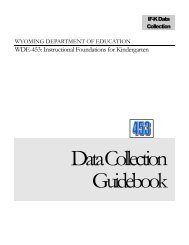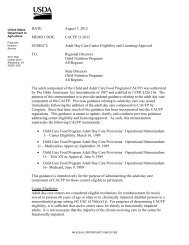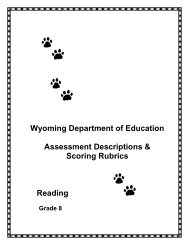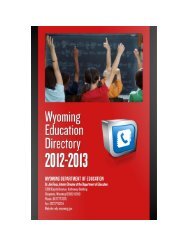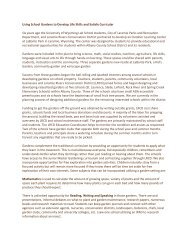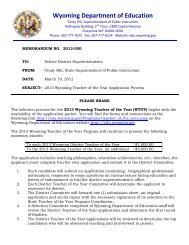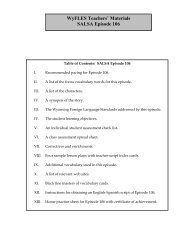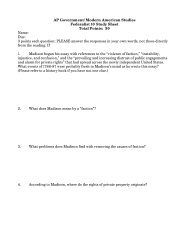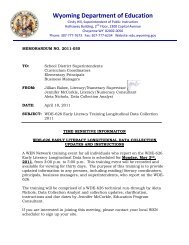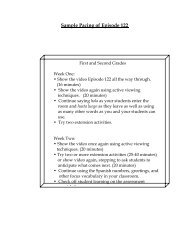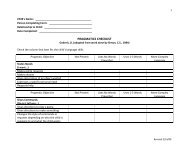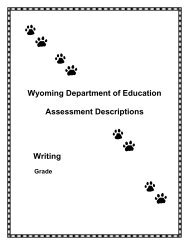Birth to Three Orientation and Mobility New Mexico Style
Birth to Three Orientation and Mobility New Mexico Style
Birth to Three Orientation and Mobility New Mexico Style
Create successful ePaper yourself
Turn your PDF publications into a flip-book with our unique Google optimized e-Paper software.
WREIC 2013<br />
Jackson Hole, WY<br />
<strong>New</strong> <strong>Mexico</strong> School<br />
for the Blind <strong>and</strong><br />
Visually Impaired<br />
Cindy Faris, TVI<br />
Julie Maner, COMS<br />
Mark Carter, COMS<br />
<strong>Birth</strong> <strong>to</strong> <strong>Three</strong><br />
<strong>Orientation</strong> <strong>and</strong> <strong>Mobility</strong><br />
<strong>New</strong> <strong>Mexico</strong> <strong>Style</strong>
EARLY<br />
IDENTIFICATION<br />
AND VISION<br />
DIAGNOSIS<br />
EARLY ID/DIAGNOSIS<br />
LEADS TO FUTURE<br />
SERVICES<br />
PRIMARY CARE DOCTORS<br />
FREQUENTLY MISS SIGNS OF<br />
VISUAL IMPAIRMENT<br />
MAJORITY OF REFERRALS FROM<br />
EI STAFF<br />
SERVING KIDS AT RISK ALLOWS<br />
OUR STAFF TO HELP WITH<br />
DIAGNOSIS<br />
WE SERVE MORE CHILDREN, B-3,<br />
THAN OTHER STATES<br />
CHILDREN RECEIVE TRANSITION<br />
SERVICES
TRENDS AND<br />
CHALLENGES<br />
STAFF MUST BE WELL<br />
TRAINED<br />
INCREASE OF OPTIC NERVE<br />
HYPOPLASIA<br />
INCREASE OF SHAKEN<br />
BABY/NONACCIDENTAL TRAUMA<br />
INCREASE OF PREMATURE BABIES<br />
INCREASE OF MEDICALLY<br />
FRAGILE BABIES
LOOKING TO THE<br />
FUTURE<br />
DEFINING<br />
OUR<br />
ROLE<br />
OUR ROLE IN THE<br />
TRANSDISCIPLINARY TEAM<br />
PROVIDER MODEL AS VISION<br />
SPECIALISTS<br />
ACTIVE PARTICIPATION AS TEAM<br />
MEMBERS WITH KIDS, FAMILIES,<br />
AND AGENCIES<br />
CONTINUED STATE AND<br />
COMMUNITY COLLABORATION<br />
MODEL FOR OTHER STATES
NMSBVI B-3 O&M Services in NM<br />
WORK CLOSELY WITH NMSBVI DEVELOPMENTAL<br />
SPECIALISTS AND OTHER TEAM MEMBERS<br />
EARLY DEVELOPMENT OF TOOL USE AND PURPOSEFUL<br />
REACHING<br />
TRY CANES AT EARLY AGE… NOT SURE HOW A CHILD<br />
WILL RESPOND TO A CANE UNLESS YOU TRY
<strong>Orientation</strong> <strong>and</strong> <strong>Mobility</strong> Definition<br />
NM Family Infant Toddler Program<br />
Services delineated in the IFSP that address<br />
purposeful <strong>and</strong> independent movement in children who<br />
are blind, visually impaired or are at risk for visual<br />
impairment. Services provided involve the<br />
development of skills including concurrent mo<strong>to</strong>r<br />
skills, sensation, environmental concepts, body image,<br />
space/time relationships, <strong>and</strong> gross mo<strong>to</strong>r skills.<br />
<strong>Orientation</strong> <strong>and</strong> mobility instruction is focused on<br />
travel <strong>and</strong> movement in current environments <strong>and</strong> next<br />
environments <strong>and</strong> the interweaving of skills in<strong>to</strong> the<br />
overall latticework of development. Services include<br />
evaluation <strong>and</strong> assessment of infants <strong>and</strong> <strong>to</strong>ddlers<br />
identified as blind/visually impaired <strong>to</strong> determine<br />
necessary interventions, equipment, <strong>and</strong> strategies <strong>to</strong><br />
promote movement <strong>and</strong> independence.
NMSBVI B-3 O&M Guiding Principles<br />
O & M SERVICES SHOULD START WHEN A CHILD IS YOUNG<br />
MOVEMENT IMPROVES COGNITIVE FUNCTIONING AND<br />
INCREASES SKILLS IN ALL DEVELOPMENTAL AREAS<br />
CHILDREN SHOULD HAVE AN OPPORTUNITY TO LEARN BY<br />
EXPLORING AND MOVING<br />
MOVEMENT SHOULD BE DEVELOPMENTALLY APPROPRIATE<br />
O & M SHOULD BE FUN, BECAUSE CHILDREN LEARN BEST<br />
THROUGH PLAY<br />
CHILD, FAMILY AND TEAM CENTERED O & M IS MOST<br />
SUCCESSFUL<br />
ACTIVE PARTICIPATION ALLOWS THE CHILD TO LEARN IN A<br />
MEANINGFUL CONTEXT.<br />
CHILDREN LEARN BEST WHEN THEY ARE ENGAGED IN<br />
NATURAL LEARNING ENVIRONMENTS.
Demographics<br />
NMSBVI <strong>Birth</strong> – 3 Years<br />
<strong>Orientation</strong> <strong>and</strong> <strong>Mobility</strong> Assessment<br />
Functional Vision Results<br />
Parent Report<br />
Communication<br />
Sensory:<br />
Audi<strong>to</strong>ry/Tactual/Olfac<strong>to</strong>ry<br />
Gross Mo<strong>to</strong>r<br />
Fine Mo<strong>to</strong>r<br />
Quality of Movement<br />
<strong>Orientation</strong><br />
<strong>Mobility</strong><br />
Concepts<br />
Travel Devices<br />
Safety <strong>and</strong> Environmental<br />
Awareness<br />
Exploration <strong>and</strong> Learning
Early O&M Devices<br />
Used for safe & independent st<strong>and</strong>ing & walking<br />
Push <strong>to</strong>ys<br />
AMD-adaptive mobility devices<br />
Precanes<br />
Canes
Active Learning<br />
Children learn by doing until the developmental age of three.<br />
The actions of examining <strong>and</strong> experimenting with objects using their bodies is<br />
the foundation for the development of cognitive, mo<strong>to</strong>r, problem-solving <strong>and</strong><br />
social skills.<br />
Our role in helping children with severe disabilities learn is <strong>to</strong> create<br />
environments that build on skills the child already has, <strong>to</strong> encourage him <strong>to</strong> use<br />
his body <strong>and</strong> mind for higher-level tasks.<br />
Dr. Nielsen has developed materials <strong>and</strong> approaches for use with children with<br />
sensory impairments <strong>and</strong> additional disabilities <strong>to</strong> help them be more actively<br />
involved with the world around them.<br />
Lilli Nielsen
Does active learning fit in<strong>to</strong><br />
<strong>Orientation</strong> <strong>and</strong> <strong>Mobility</strong>?<br />
Find ways for child <strong>to</strong> learn<br />
about his environment in an<br />
active purposeful way.<br />
COMS can set up activities<br />
<strong>and</strong> learning opportunities.<br />
Involve family <strong>and</strong> other<br />
early interventionists with<br />
planning activities.<br />
Ensure activity is in child’s<br />
learning zone.<br />
Relate skills being used <strong>to</strong><br />
future O&M skills.<br />
VIISA training in NM<br />
Active Learning
THANK YOU<br />
QUESTIONS????



